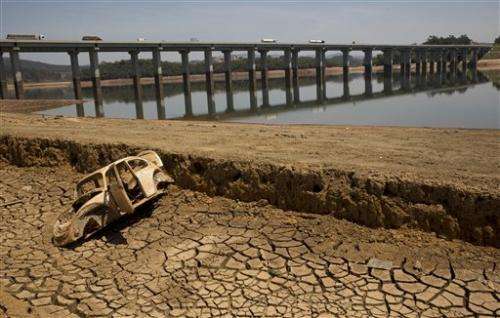Biggest reservoir for Brazil's largest city is running dry

Halfway through the rainy season, the key reservoir for the hemisphere's largest city holds just 6 percent of its capacity, and experts warned Friday that Sao Paulo authorities must take urgent steps to prevent the worst drought in more than 80 years from drying it out.
The system of reservoirs and rivers that provide water to millions in this city have received less rainfall than hoped during the first weeks of the wet season, raising fears they won't be replenished as hoped. Rainfall during the first two weeks of January totaled just 2.9 inches (7.1 centimeters), well below the historic average for the month of 10.7 inches (27.1 centimeters).
The biggest problem is in the Cantareira water system, which is the largest of six reservoirs that provide water to some 6 million of the 20 million people living in the metropolitan area of Sao Paulo city. Cantareira is now down to 6 percent of its capacity of 264 billion gallons (1 trillion liters), the water utility Sabesp said on its website.
Of the remaining five systems, Alto Tiete is at 11 percent of capacity, Rio Claro 25 percent, Alto Cotia 30 percent, Guarapiranga 40 percent and Rio Grande 70 percent.
"The water supply situation is critical and could become even more critical if the lack of rain and hot weather continue and effective demand management techniques are not created," Mario Thadeu Leme de Barros, head of the University of Sao Paulo's hydraulic engineering and environmental department, said by phone.
Although declining water supplies have been a concern since last year, authorities have resisted rationing water. But Leme de Barros said officials need to consider a range of steps, among them implementing water rationing but also encouraging the use of more efficient appliances, lowering water pressure in the system and doing better at repairing leaks.
"Sao Paulo's water situation is in the intensive care unit and the worse will only be avoided if these measures are adopted and, of course, if it starts raining more," he Barros said.
The Sao Paulo state government said its measures to conserve water are working, such as offering discounted water bills for those who limit usage and reducing water pressure during off-peak hours. The government also has said it will double the bills of some customers who increase consumption above monthly averages.
Earlier this week, Sabesp's president, Jerson Kelman, said that to help prevent Cantareira from drying up, the utility would reduce the flow of water out of the reservoir.
© 2015 The Associated Press. All rights reserved.


















